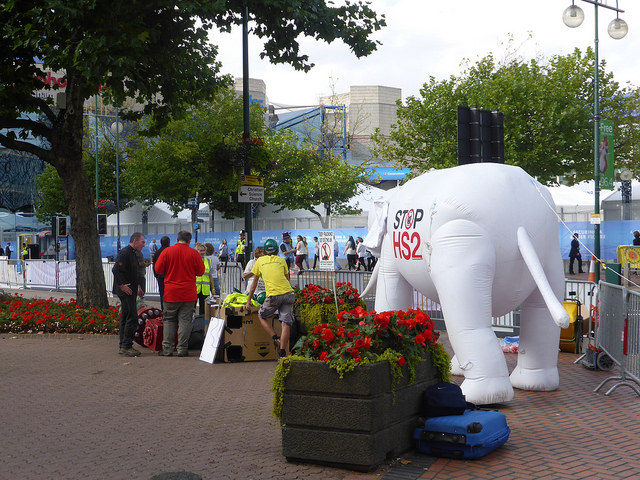The potential for public dialogue and deliberation in the development of national infrastructure policy
Infrastructure spending has come under the microscope recently, with projects like the creation of a new high speed rail line, and the mooted expansion of Heathrow Airport showing the difficulty of persuading everyone of the merit of the project in question. Ian Thompson asks whether it is possible to have genuine public deliberation on a high speed rail line or a public dialogue about an electricity connection.

Credit: metrogogo, CC BY NC SA 2.0
On Monday 3 March 2015, Dialogue by Design and the UCL Transport Institute co-hosted a seminar, We Need to Talk about Infrastructure, chaired by Jim Steer of Steer Davies Gleave. We posed a simple question: when Government plans to invest £375 billion in infrastructure projects up to 2020, how can this be done with local communities, rather than against them?
A key objective of the event was to encourage comparison and learning from public engagement practice in other sectors, and two of our speakers explored this theme in their presentations, looking at good practice in engagement and dialogue. Dr Jack Stilgoe talked about moving infrastructure up-stream, while Dialogue by Design’s Chief Executive Dr Diane Beddoes spoke of how to improve the quality of engagement on infrastructure generally, and the need to move beyond an approach based purely on compliance with legal requirements that characterises many such projects. Both these speakers referred to dialogue projects run by Sciencewise, the UK’s national centre for public dialogue in policy making involving science and technology, which uses innovative methods to engage the public on complex and controversial issues.
It is clear that there is a lot of room for improvement in engagement on major infrastructure, as the recent Green Alliance report Opening up Infrastructure Planning documented in detail. On the other hand, the table discussions at the event threw up many of the unique challenges of engaging on major projects. These challenges would appear to be a significant barrier to the more exploratory, open-ended approaches to dialogue associated with Sciencewise. Are these approaches applicable to major infrastructure schemes, or is infrastructure a special case for dialogue?
Perhaps the most obvious challenge associated with engagement on major infrastructure schemes in contrast to many public dialogues is the number of people directly (or at least potentially) affected. While science and technology policy has the potential to affect an equally large, even greater number of people, the impacts of a major infrastructure scheme are clearly unequal. Those potentially affected have a clear stake in the scheme, and the need for such individuals and organisations to be represented directly in the engagement (as opposed to indirectly through a representative focus group sample) limits the choice of methods and discourages innovation. One participant went as far as to ask if there was a direct trade-off between the scale of engagement and its quality.
Other participants reflected that the challenges associated with pre-application consultation are often compounded by the timetable of engagement on major infrastructure. In particular, those potentially affected often continue to return to discussion of the need case even at later stages where options are presented and proposals are refined. What we might refer to as the inevitable ‘messiness’ of these projects (in terms of this interplay between interests and narrative) presents clear challenges for formal consultation processes.
On the other hand, we could see a potential application of more dialogue-based processes here: the use of more deliberative methods, unrestricted by the linear process of formalised consultation could help to explore the relationship between views on strategic issues and concerns about local impacts.
Transparency and the need for a clear audit trail are key requirements of major infrastructure schemes, and they limit the choice of appropriate methods for engagement. Promoters of these schemes are subject to strict regulatory requirements to demonstrate that public views and concerns have been sought and considered. This is particularly the case with those schemes designated ‘Nationally Significant Infrastructure Projects’ which are subject to the prescriptive requirements for pre-application engagement and consultation set out in the Planning Act 2008. As Dr Jack Stilgoe admitted in relation to the dialogue on synthetic biology, while a Sciencewise-style dialogue allows for public deliberation of deeply controversial and complex topics, it doesn’t facilitate this need for auditability.
This is not just about the requirements of scheme promoters: the participant perspective is important here too. When talking about building trust in engagement processes, one participant emphasised the importance of respondents (or participants) being able to see how their views will affect the outcome, otherwise simply asking for views can seem like a ‘one-way process’.
Finally, cost may be another factor, especially in the context of publicly funded developments. For example, one promoter noted that it was difficult to secure funding for behavioural research. To some extent this reflects that public engagement, viewed as something auxiliary to the overall planning and development of a scheme, is often not a priority for funding and project management in general. But it was encouraging that Will Bridges from National Grid’s North West Coasts Connection project asserted in his presentation that engagement and consultation, if done properly, actually reduce the overall timescale of the project as well as improving the final proposals for the scheme. This recognition was reiterated in table discussions.
Despite the points raised in discussions about the unique challenges faced by practitioners in this field, comments from the event suggest that there is a clear enthusiasm on the part of promoters for improving the quality of their engagement methods and processes. For example, one promoter shared their experience of using behavioural research alongside a formal consultation process. As well as allowing them to “explore the perspectives and needs of specific groups”, they also noted that this encouraged participants to consider and engage with the views and interests of others – hinting at the social compromise implied in Professor Brian Collins’ term ‘shared infrastructure’. Another participant suggested that consultation was often too serious and ‘stuffy’ and that presenting issues in a more fun way would make them more accessible and engaging. They mentioned a government consultation on parks which made use of a video game to encourage participation. These examples have a similar rationale to the Department of Energy and Climate Change’s (DECC) online 2050 simulation tool which Dr Diane Beddoes referred to in her presentation, encouraging people to engage with the trade-offs involved in strategic policy – a form of deliberation.
It’s clear that to some extent infrastructure is a special case for dialogue. That’s not to say that more innovative and engaging methods can’t be applied though, just that promoters will have to be more proactive and inventive in applying them. The enthusiastic participation in our event suggests that there is hope on this front. As we’ve seen, there is potential for dialogue approaches to be used alongside the formal statutory consultation process, helping views to be explored in greater depth. Moreover, at a more strategic level – in the development of national infrastructure policy, for example, it is far easier to see the possibilities of a Sciencewise-style public dialogue.
—
This chapter is an extract from the Infrastructure and the Citizen policy paper, which can be downloaded for free from the OPM website.
You may also be interested in two other posts from this series: ‘Only an approach founded on rights and obligations can allow for effective and legitimate public infrastructure provision‘ by Elena de Besi, and ‘‘Depoliticising infrastructure’: can a strategic approach enhance public engagement?‘ by Morgan Wild.
This article gives the views of the authors, and not the position of Democratic Audit, nor of the London School of Economics. Please read our comments policy before posting.
—
 Ian Thompson is an Analysis Manager at Dialogue by Design (OPM Group)
Ian Thompson is an Analysis Manager at Dialogue by Design (OPM Group)





 Democratic Audit's core funding is provided by the Joseph Rowntree Charitable Trust. Additional funding is provided by the London School of Economics.
Democratic Audit's core funding is provided by the Joseph Rowntree Charitable Trust. Additional funding is provided by the London School of Economics.
[…] may also be interested in two other posts from this series: ‘The potential for public dialogue and deliberation in the development of national infrastructure pol…‘ by Ian Thomson and ‘Only an approach founded on rights and obligations can allow for […]
[…] may also be interested in two other posts from this series: ‘The potential for public dialogue and deliberation in the development of national infrastructure pol…‘ by Ian Thomson, and ‘‘Depoliticising infrastructure’: can a strategic approach […]
RT @sburall: What potential for public deliberation in the development of national infrastructure policy? <lots! https://t.co/38V5UZ0Fhn
What is the potential for public #dialogue & #deliberation on #infrastructure? https://t.co/EtG5EfD70m @DbyDteam blog for @democraticaudit
What potential is there for public dialogue and deliberation on #ukinfrastructure? https://t.co/mIkl4R2pBq
The potential for public dialogue and deliberation in the development of national infrastructure policy https://t.co/zxHZlP9BPm
The potential for public dialogue and deliberation in the development of national infrastructure policy https://t.co/SUuLUvqhZm #Option2Sp…
The potential for public dialogue and deliberation in the development of national… https://t.co/7aGv3B71d7 https://t.co/kzuRLhFo2q